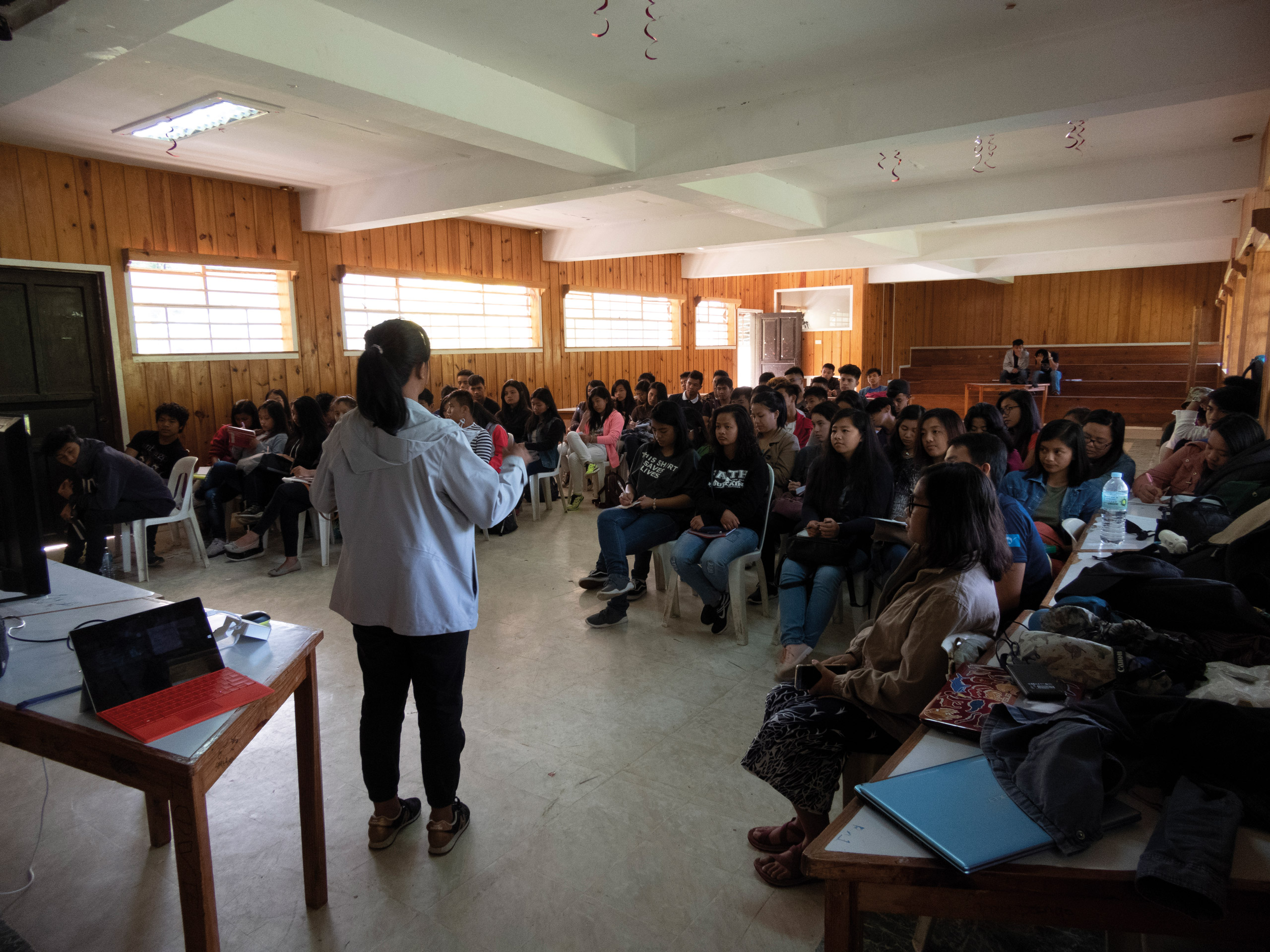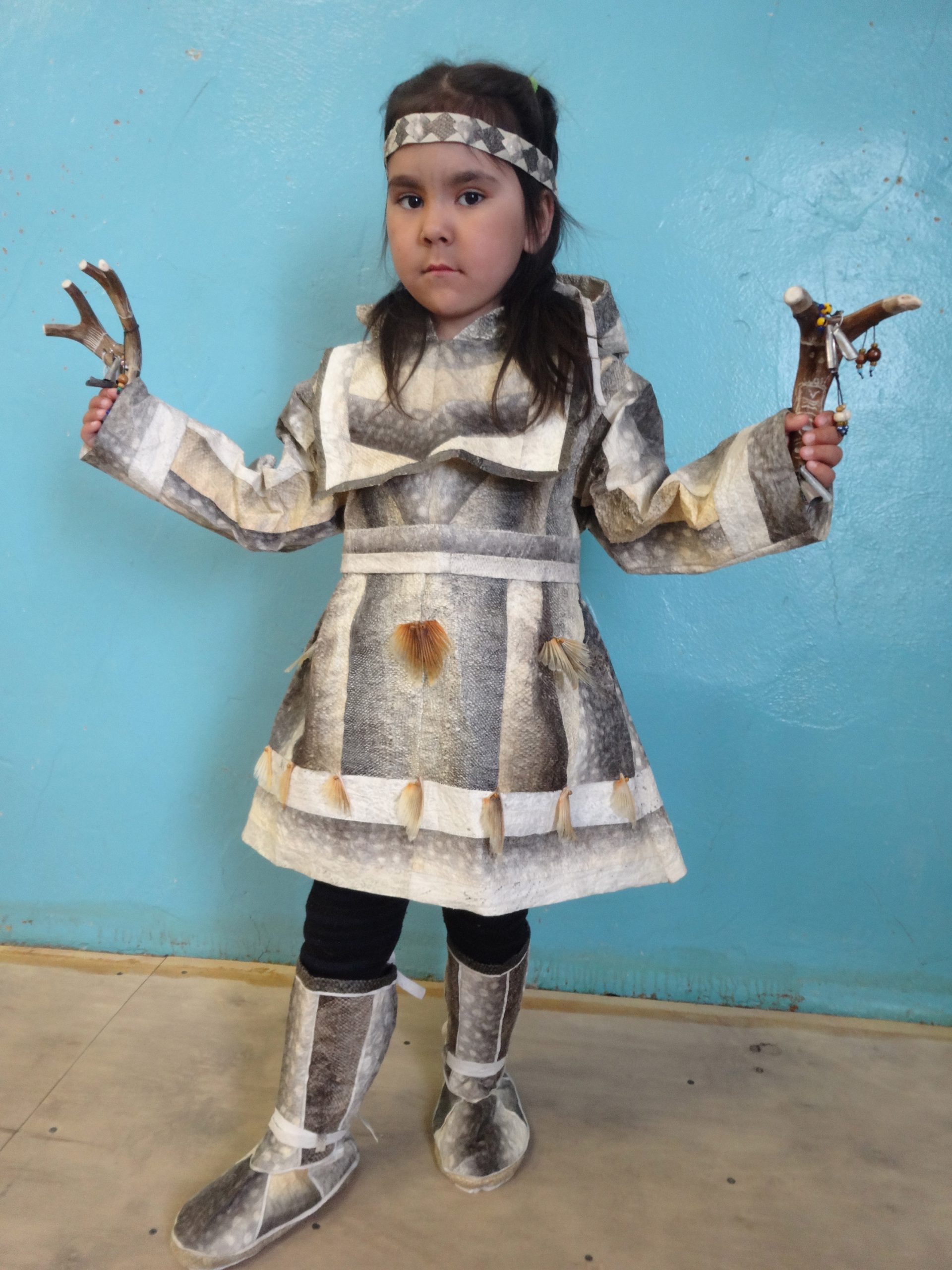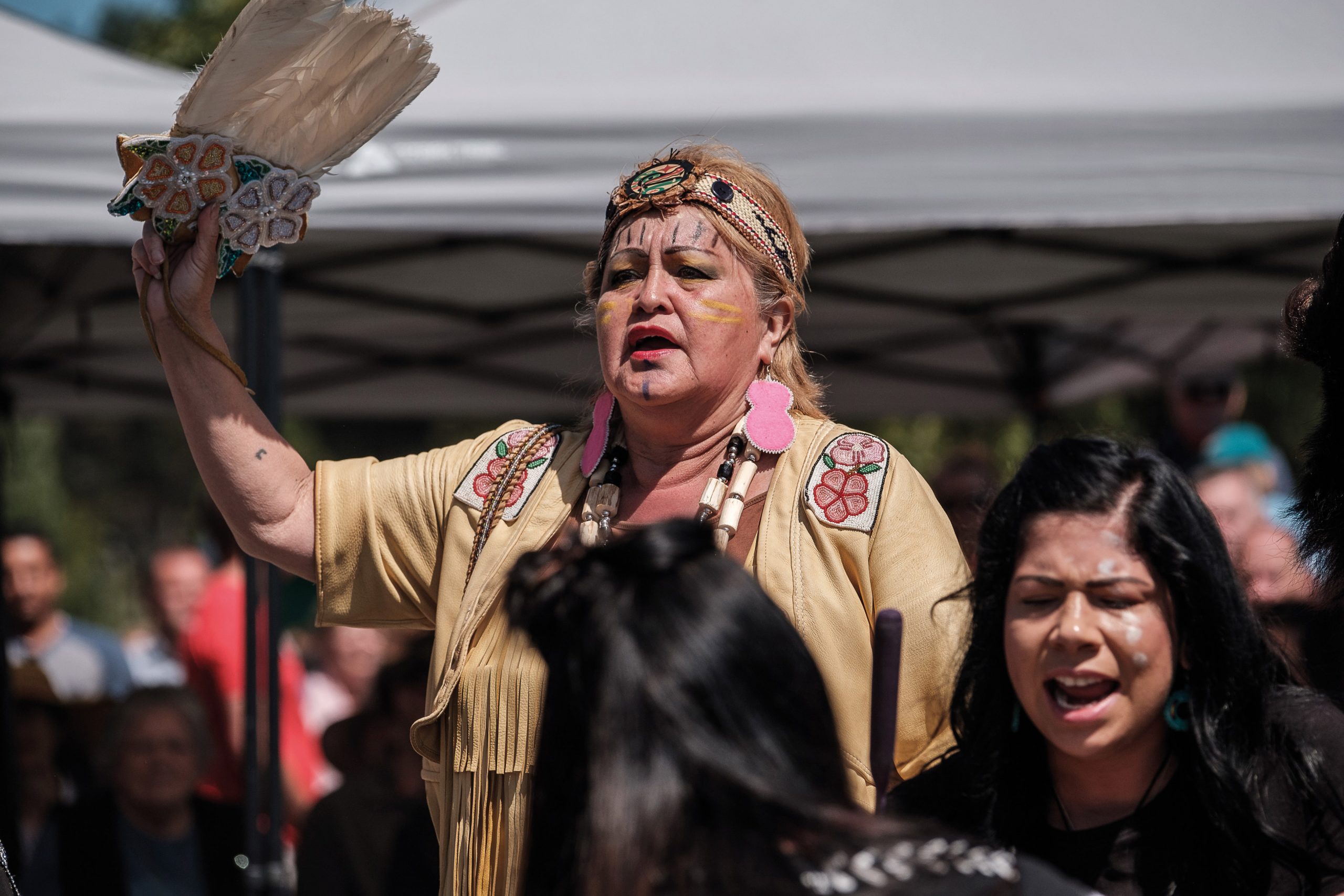
Target 1: Awareness of biodiversity increased
By 2020, at the latest, people are aware of the values of biodiversity and the steps they can take to conserve and use it sustainably.
Key messages
- The 2050 vision of a world ‘living in harmony with nature’1 requires a radical paradigm shift in value systems away from economic values alone towards value systems that emphasise connections between people, nature and living well.
- Many indigenous peoples and local communities (IPLCs) have value systems embodying principles of respect, reciprocity and ethical living, which need to be supported and strengthened against cultural erosion.
- Sharing these value systems more widely within educational systems and with the general public contributes significantly towards shifting understanding of intercultural perspectives and diverse biodiversity values.
Significance of Target 1 for IPLCs
“The value that is placed on natural resources by state and companies is a dollar value. For us, that’s not the same. Mother Nature is more than a dollar value. She’s a part of who we are.”
— J Cristina Coc, indigenous Q’eqchi, Maya Leaders Alliance2
Box 1: John Bamba3
Relational values with nature; the Jalai Daya in Kalimantan, Indonesia
Among the Jalai Daya in Kalimatan, Indonesia, an ideal life can be achieved through living in accordance with the following cultural values:
- Sustainability (biodiversity) versus productivity (monoculture)
- Collectivity (co-operation) versus individuality (competition)
- Naturality (organic) versus engineered (inorganic)
- Spirituality (rituality) versus rationality (scientific)
- Process (effectiveness) versus result (efficiency)
- Subsistence (domesticity) versus commerciality (market)
- Customary law (locality) versus state law (global)
Failure to achieve these ideals is believed to result in barau (a situation when nature fails to function normally, resulting in chaos). Barau comes about as a result of transgression of adat (customary practice), when there is a broken relationship with nature.
— Read the full case study
Many IPLCs live by principles and values related to the concept of living well (for example, in Ecuador sumak kawsay4, or buen vivir, refers to living well in harmony with nature). Typically, such holistic approaches emphasise local sources of food and livelihoods; community solidarity; intergenerational governance; resilient ecosystems; spiritual, economic and social connection to lands and territories; the protection of systems of knowledge transfer; customary sustainable use of resources; and collective benefit-sharing. Nature is more likely to be protected and maintained on IPLC lands and territories where these principles are enabled and upheld.
IPLCs, in not seeing nature (or biodiversity) as a separate external entity, provide an important counterpoint to the dominant western paradigm. It will be critical for peoples and societies to embrace more holistic, relational value frameworks that emphasise living in harmony with nature if we are to address the current environmental crisis.5
Contributions and experiences of IPLCs towards Target 1
IPLCs have been active in revitalising, restoring and protecting their knowledge and values through creating spaces for intergenerational learning and knowledge-sharing, mostly within communities and conducted in local languages. Specific activities include creating intergenerational learning programmes; creating culturally sensitive learning spaces; organising community-based nature and cultural events; running community-based training, and information and legal centres; and co-producing educational resources with the government. Initiatives may be enhanced through the use of modern technologies to, for example, record elders and store knowledge in secure databases.
Creating culturally sensitive learning spaces and cultural events
Culturally sensitive learning spaces and activities provide opportunities to share culture and identity, including values and knowledge. They are chances to renew pride and are also occasions for others to increase their awareness and understanding.
- In Malaysia, PACOS Trust (Partners of Community Organizations in Sabah (PACOS) Trust) worked with 22 village partners to set up community learning centres and community kindergartens where the teachers and students are themselves villagers. Today, many of the centres also serve as libraries and spaces for community engagement and activities such as talks, village meetings, workshops, and relief centres.
- International Day of the World’s Indigenous Peoples is celebrated annually on 9 August. Cultural and food festivals have been organised in Suriname, Cambodia and northeast India, while Vietnam and Timor-Leste have held workshops on mother-tongue and intergenerational learning. In Bangladesh and Nepal, roundtable discussions and meetings with government officials were organised. In the US, there is a rise in the appreciation of the significance of celebrating Indigenous Peoples’ Day in place of Columbus Day. Eleven states (Alaska, Louisiana, Maine, Michigan, Minnesota, Nevada, New Mexico, Oregon, South Dakota, Vermont and Wisconsin) observe some version of Indigenous Peoples’ Day, along with more than 100 cities, including Washington DC.6
- In Russia, the first nomadic kindergarten was established by reindeer herders and their communities in Yakutia in 1992. It was designed so that the teachers moved with the herders as they travelled across the tundra. At that time, Yakutia was autonomous from the federal government and the communities did what they considered necessary for their children (Yakutia is now an autonomous district, or okrug, of Russia). Local authorities supported the initiative and allocated money for teachers’ salaries but all other expenses (e.g. transportation, gas, accommodation, winterised yurts, special books, training consumables) were covered by the communities. By the end of the 1990s, there were seven nomadic schools in Yakutia. At the beginning of the 21st century, the initiative was gradually replicated in other Arctic regions of Russia i.e. the Yamal-Nenets and Khanty-Mansi autonomous districts; the Komi and Sakha republics; and the Arkhangelsk region. Since 2003, these schools have been receiving a small amount of support from UNESCO and foreign foundations, thus popularising and raising the status of these schools, resulting in increased funding from within the regions and official authorities. The schools have shown excellent results and raised awareness of the significance of reindeer herders leading a nomadic lifestyle.78
IPLCs have undertaken wide-ranging activities to share their values and worldviews, both within their own communities and through engagement with the wider public, including through policy advocacy; public communication and information campaigns; and educational programmes, including in mainstream school curricula. They are also working to ensure that their diverse values are passed down to future generations, and that young people develop the skills needed to continue to raise awareness on these issues.
Box 2: Josefa Cariño Tauli, Ibaloi-Kankanaey, Philippines
High school students share ideas for environmental projects that could be run locally. Credit: Paulo Kim.

Case study: Environmental leadership workshops for indigenous youth in Mountain Province, Philippines
Many initiatives led by indigenous youth are contributing to achievement of the Aichi Biodiversity Targets, and when they are supported, they have the potential to effect and innovate positive change in their communities. This was made clear to us through a series of youth-led seminar-workshops on the role of indigenous youth in environmental leadership which we had organised for senior high-school students in the municipalities of Besao and Sagada in the Cordillera Region, Philippines. The project was supported by Conservation International’s Indigenous Leaders’ Conservation Fellowship.
— Read the full case study
Box 3: Tatiana Degai, Council of Itelmens, ‘Tkhsanom’
Case study: Salmon conservation, indigenous education, and knowledge co-production in Kamchatka
Kamchatka Peninsula on the North Pacific coast of Russia is home to 12 species of salmonid fish, including six species of Pacific wild salmon. It is the last remaining region that acts as a global reserve and gene pool for salmon. Salmon form the wealth of Kamchatka and its peoples, and its sustainability determines the economic, spiritual and cultural domains of local life.
— Read the full case study

A girl wears an outfit made out of salmon skins. Credit: Itelmen crafts studio, Ujirit.

Celebrating National Indigenous Peoples Day in British Colombia, Canada. Credit: Province of British Colombia.
Opportunities and recommended actions
- IPLCs should revitalise the intergenerational transmission of their values, cultures and languages, celebrating the distinctive contributions of elders, youth and children, men and women, and their spiritual relationships with nature.
- Governments, conservation organisations and educational agencies should promote intercultural learning and education, and the transmission of traditional knowledge, building on IPLC initiatives, including those led by women and youth.
- Governments and intergovernmental institutions should strengthen and upscale inclusion of IPLC values and knowledge in mainstream education systems, including the active promotion of indigenous languages, through meaningful participation and partnerships with IPLCs.
Key resources
- Convention on Biological Diversity (2018) The Sharm El-Sheikh Declaration on Nature and Culture. CBD/COP/14/INF/46. Montreal: Convention on Biological Diversity.
- Pope Francis (2015) Encyclical Letter Laudato Si’ of the Holy Father Francis on Care for our Common Home. Vatican: The Holy See. Available at: http://www.vatican.va/content/francesco/en/encyclicals/documents/papa-francesco_20150524_enciclica-laudato-si.html
- UNESCO Strategic Outcome Document of the 2019 International Year of Indigenous Languages. Available at: http://en.iyil2019.org
References
- Convention on Biological Diversity (2018) ‘Long-term strategic directions to the 2050 vision for biodiversity, approaches to living in harmony with nature and preparation for the post-2020 Global Biodiversity Framework’. Note by the Executive Secretary. Available at: https://www.cbd.int/doc/c/0b54/1750/607267ea9109b52b750314a0/cop-14-09-en.pdf
- Mrkusic, M., Virnig, A., Sommerschuh, M. and Ervin, J. (2018) ‘Land guardians: Securing indigenous land rights in Belize as a strategy to combat climate change’. United Nations Development Programme ‘Equator Initiative’. Available at: https://equatorinitiative.exposure.co/land-guardians
- For further information on this case, please see: Bamba, J. (2003). ‘“Seven Fortunes vs. Seven Calamities:” Cultural Poverty from an Indigenous Perspective’. In Indigenous Affairs 1/03 – Indigenous Poverty: An issue of rights and needs. Copenhagen: International Work Group for Indigenous Affairs
- TEBTEBBA (2012) Indigenous Peoples Contributions to Sustainable Development. Baguio: Tebtebba. Available at: http://www.tebtebba.org/index.php/content/209-indigenous-peoples-contributions-to-sustainable-development
- Butchart, S. H. M., Miloslavich, P., Reyers, B. and Subramanian, S. M. (Draft) ‘Chapter 3. Assessing Progress towards Meeting Major International Objectives Related to Nature and Nature’s Contributions to People’, in IPBES Global Assessment on Biodiversity and Ecosystem Services. Bonn: IPBES.
- Indigenous Peoples Human Rights Defenders Network (2019) ‘Country celebration of The International Day of the World’s Indigenous Peoples’. Chiang Mai: Indigenous Peoples Human Rights Defenders Network. Available at: https://iphrdefenders.net/the-international-day-worlds-indigenous-peoples-2019/
- Indigenous Peoples Human Rights Defenders Network (2019) ‘Country celebration of the International Day of the World’s Indigenous Peoples’. Chiang Mai: Indigenous Peoples Human Rights Defenders Network. Available at: https://iphrdefenders.net/the-international-day-worlds-indigenous-peoples-2019/
—
Al Jazeera (2019) ‘Which US States are celebrating Indigenous Peoples’ Day?’. Doha: Al Jazeera. Available at: https://www.aljazeera.com/news/2019/10/states-celebrating-indigenous-people-day-191014172801125.html
—
Fadel, L. (2019) ‘Columbus Day or Indigenous Peoples’ Day?’. Washington D.C.: NPR. Available at: https://www.npr.org/2019/10/14/769083847/columbus-day-or-indigenous-peoples-day - Russian News Agency TASS (2017) ‘Russian Arctic regions organize nomadic kindergartens, schools’. Moscow: Russian News Agency TASS. Available at: https://tass.com/economy/941370
—
Arctic Council and Sustainable Development Working Group (n.d.) ‘Arctic preschool education’. Arctic Council and Sustainable Development Working Group. Available at: https://www.sdwg.org/activities/sdwg-projects-2017-2019/arctic-preschool-education/


